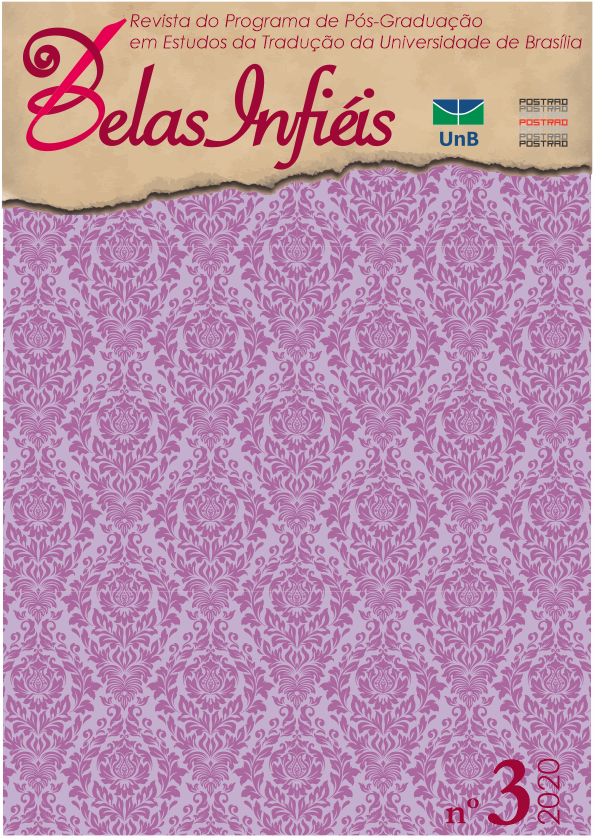Biblical Hermeneutics through Anthroponyms. Its Chances “after Babel”
DOI:
https://doi.org/10.26512/belasinfieis.v9.n3.2020.30830Palabras clave:
Traductology. Textology. Biblical Hermeneutics. Anthroponymy.Resumen
Quite often (especially with the Old Testament), biblical anthroponyms may be described as dynamic names, since they contribute to the construction of a text’s content, and are active elements in the process of transmitting that meaning towards a different cultural space or cultural time. Consequently, the way in which translators of the Bible deal with them, intentionally or accidentally, affects a target-reader’s chances to grasp the originally intended message of the text. The present paper follows the avatars of Job’s daughter’s names (cf. Job 42: 14) from Hebrew, to Greek and Latin, and, late on, to vernaculars such as Romanian, and suggests that ”“ while equally explainable contextually and/or pragmatically ”“ different translating options achieve different levels of relevance, or representativeness, relative to the original text, and, in fact, to the multileveled and intricate translative intentions.
Descargas
Citas
ADLER, C. et al. (Editorial Board). Jewish Encyclopaedia, 1901-1906. http://www.jewishencyclopedia.com/ .
Anthologie grecque. Première partie, Anthologie palatine. Tome X (Livre XI). Texte établi et traduit par Robert Aubreton, Paris: Société d’Édition « Les Belles Lettres », 1972.
BAILLY, A. Dictionnaire Greque-Français, Paris: Hachette, [s.a.].
BALLARD, M. Le nom propre en traduction, Gap, Paris: Ophrys, 2001.
BRÉAL, M. Semantics. Studies in the Science of Meaning (Translated by Henry Cust), New York, 1900.
BROWN, F. The Brown-Driver-Briggs Hebrew and English Lexicon. With an appendix containing the Biblical Aramaic, Oxford: Clarendon Press, 1907.
CORBEA, T. Dictiones latinae cum valachica interpretatione. Ediţie de Alin Mihai Gherman, Cluj, 2001.
WAARD, de, J., NIDA, E.A. From One Language to Another. Functional Equivalence in Bible Translating, Nashville: Thomas Nelson Publishers, [1986].
DLR. DicÅ£ionarul limbii române, Tomul I, Partea II, C, BucureÅŸti, 1940.
GAFFIOT, F. Dictionnaire latin-français, Paris: Hachette [s.a.].
GAFTON, A. Numele în Biblie, in AUI, IIIe. Lingvistică, t. LI, 2005, pp. 165-179.
GEERAERTS, D. Words and Other Wonders. Papers on Lexical and Semantic Topics, Berlin/New York: Mouton de Guyter, 2006.
HUMPHREY, C. “On Being Named and Not Named: Authority, Persons, and Their Names in Mongolia”. The Anthropology of Names and Naming, edited by Gabriele vom Bruck, Barbara Bodenhorn, Cambridge UP, 2006, pp. 158-176.
JOOSTEN, J. Sermon on Job, Holocaust Memorial Sunday, 2019, Oriel college, Oxford, 27 Jan. 2019. https://www.academia.edu/38903344/Sermon_on_Job_Holocaust_Memorial_Sunday_2019.
JOOSTEN, J. “Translating the Untranslatable: Septuagint Renderings of Hebrew Idioms”. Translation Is Required”: The Septuagint in Retrospect and Prospect, edited by R. Hiebert, Leiden: Brill / Atlanta: SBL, 2010. pp. 59-70.
LAYNE, L. “‘Your Child Deserves a Name’: Possessive Individualism and the Politics of Memory in Pregnancy Loss”. The Anthropology of Names and Naming, edited by Gabriele vom Bruck, Barbara Bodenhorn, Cambridge UP, 2006, pp. 31-50.
LIDDELL-SCOTT. A Greek-English Lexicon, Compiled by Henry George Liddell, Robert Scott, A New Edition Revised and Augmented throughout by Sir Henry Stuart Jones, Oxford, [s.a.].
LUNGU-BADEA, G. “Note cu privier la traducerea numelor proprii literare”. Studii de traductologie românească. I. Discurs traductiv, discurs metatraductiv, coord. Georgiana Lungu-Badea, Nadia Obrocea, TimiÈ™oara: Editura Universității de Vest, 2017, pp. 251-266.
PEIRCE, C.S. The Essential Peirce, vol. 2, Bloomington and Indinalopils: Indiana UP, 1998.
PLATO, “Symposium”. Plato in Twelve Volumes, Vol. 9. Translated by Harold N. Fowler. Cambridge: MA, Harvard University Press; London: William Heinemann Ltd. 1925.
ROSEN, M. Eseuri biblice, BucureÅŸti: Hasefer, 1992.
RYKEN, L. et al. Dictionary of Biblical Imagery (electronic ed.), Downers Grove, IL: InterVarsity Press.
Septuaginta 4/II. Septuaginta. Iov, ÎnÅ£elepciunea lui Solomon, ÎnÅ£elepciunea lui Sirah, Psalmii lui Solomon. Volum coordonat de: Cristian Bădiliţă, Francisca Băltăceanu, Monica BroÅŸteanu, [s.l.], Polirom, 2006.
STAMATI, T. DisionăraÅŸu românescu de cuvinte tehnice ÅŸi altele greu de înÅ£elesu, IaÅŸi, 1851.
STRONG. Strong’s Concordance. http://concordances.org/hebrew/1126.htm
SWANSON, J. Dictionary of Biblical Languages with Semantic Domains: Hebrew (Old Testament) (electronic ed.). Oak Harbor: Logos Research Systems, Inc., 1997.
TDRG2. TIKTIN, H. Rumänisch-Deutsches Wörterbuch, ed. a II-a, überarbeitete und ergänzte Auflage von Paul Miron, Band I-III, Wiesbaden: Otto Harrassoowitz, 1986, 1988, 1989.
Testamentul lui Iov, in Trei apocrife ale Vechiului Testament: Iosif ÅŸi Aseneth, Testamentul lui Iov, Testamentul lui Avraam, IaÅŸi, Polirom, 2000.
THAYER. A Greek-English Lexicon of the New Testament Being Grimm’s Wilke’s Clavis Novi Testamenti, Translated, Revised and Enlarged by Joseph Henry Thayer, D.D., 1889.
TRASK, R.L. Language and Linguistics. The Key Concepts, Routledge, 2007.
Descargas
Publicado
Cómo citar
Número
Sección
Licencia
Derechos de autor 2020 Belas Infiéis

Esta obra está bajo una licencia internacional Creative Commons Atribución 4.0.
Copyright Statement
Given the public access to this journal, the texts are free to use but requires the recognition of the original authorship and initial publication in this journal to be properly stated.
The journal allows the use of works published for non-commercial purposes, including the right to submit the work to publicly accessible databases. Published contributions are the sole and exclusive responsibility of the author(s).
- When submitting papers to be evaluated by the Belas Infiéis journal, the author(s):
- Declare that the contents of the contributions are original and of their original creation, being entirely responsible for their content if there is an objection by third parties.
- Claim to be aware that they should not commit academic plagiarism.
- Declare that the manuscript has not been published, completely or partially, in Portuguese or another language. If it is a translation it should be submitted to the Translated Articles section.
- Declare that the manuscript is not being evaluated by other journals.
- Declare that the manuscript was not submitted to another journal simultaneously.
- Commit(s) to inform the journal of any kind of error or inaccuracy in their contribution (published, in evaluation or in editing) and to collaborate with the editors to make due corrections of the article (when in evaluation or editing) or erratum/retraction (after publication).
- Declare that there is no conflict of interest regarding the published work.
- Authorize its release if it is accepted for publication without any kind of monetary compensation.
- Agree to assign non-exclusive rights to publication to the magazine, remaining free to make their contribution available in other media as long as the publication of the first version in Belas Infiéis magazine is mentioned. They also authorize Belas Infiéis to assign their texts for reproduction in content indexers, virtual libraries and similar platforms.
- Maintain copyright and grant the journal the right of first publication, the work being licensed under theCreative Commons Attribution License.
- Is/Are allowed and encouraged to publish and distribute their work online after the editorial process, which may increase the impact and citation of the published work.
- Authorize the editorial team to make textual adjustments and to adapt the article to the publication rules, when necessary.



















